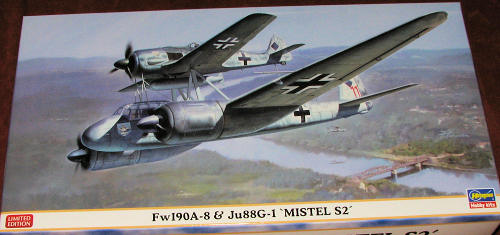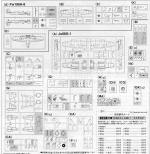
Hasegawa 1/72 FW-190A & Ju-88G-1 "Mistel S2"
| KIT #: | 01975 |
| PRICE: | 3,360 yen (about $43.00) on discount from www.hlj.com |
| DECALS: | Two Options |
| REVIEWER: | Scott Van Aken |
| NOTES: | Two kits. Updated parts to make the Mistel |

| HISTORY |
The Mistel (German for "Mistletoe"), also known as Beethoven-Gerät (Beethoven Device) and Vati und Sohn (Daddy and Son), was a Luftwaffe composite aircraft type of bomber introduced in the later stages of World War II.
Mistel was originally a bomber airframe, usually a Junkers Ju 88 variant, with the entire nose-located crew compartment replaced by a specially-designed nose filled with a large load of explosive, with a fighter aircraft on top, joined to the bomber by struts. The combination would be flown to its target by a pilot in the fighter; then the unmanned bomber was released to hit its target and explode, leaving the fighter free to return to base. The first such composite aircraft flew in July 1943 and was promising enough to begin a programme by Luftwaffe test unit KG 200, code-named "Beethoven".
The definitive Mistel warhead was a shaped charge of nearly two tons in weight fitted with a copper or aluminium liner. The use of a shaped charge was expected to allow penetration of up to 7 meters of reinforced concrete.
Some 250 Mistels of various combinations were built during the war, but met with limited success. They were first flown in combat against the Allied invasion fleet during Battle of Normandy, targeting the British-held harbour at Courseulles-sur-Mer.
While Mistel pilots claimed hits, none of these match Allied records; they may have been made against the hulk of the old French battleship Courbet, which had been included as a component of the Mulberry harbour at Arromanches and specially dressed up as a decoy by the Allies. Serious blast and shrapnel damage from a near miss was suffered by HMS Nith, a floating headquarters, on 24 June. Nine men were killed and 26 wounded, and Nith was towed back to England for repairs.
A second opportunity to use the Mistels, in Scapa Flow in 1944, was abandoned after the sinking of the German battleship Tirpitz led to the departure of all the Royal Navy's major surface units from the target.
As part of Operation Iron Hammer in late 1943 and early 1944, Mistels were selected to carry out key raids against Soviet weapons-manufacturing facilities—specifically, electricity-generating power stations around Moscow and Gorky. These plants were known to be poorly defended by the Soviets and irreplaceable. However, before the plan could be implemented the Red Army had entered Germany, and it was decided to use the Mistels against their bridgehead at Küstrin instead. On 12 April 1945, Mistels attacked the bridges being built there, but the damage caused was negligible and delayed the Soviet forces for only a day or two. Subsequent Mistel attacks on other bridges being thrown across the Oder were similarly ineffective.
The Mistel 2 was a combination of the FW-190A-8 or F-8 combined with a Ju-88G-1 airframe. The trainer version, which had no warhead, was the Mistel S2.
| THE KIT |
 This one is a bit unique in terms of Hasegawa's double kits. It mates the
venerable Hasegawa 1/72 FW-190A-8 kit with their Ju-88G-1 night fighter kit
and includes the additional bits needed to make the unusual Mistel
combination.
This one is a bit unique in terms of Hasegawa's double kits. It mates the
venerable Hasegawa 1/72 FW-190A-8 kit with their Ju-88G-1 night fighter kit
and includes the additional bits needed to make the unusual Mistel
combination.
This is not the first Mistel in this scale as Italeri did the Mistel 1 using their Ju-88 and horrible Bf-109F kit in 1/72. AMtech also did the lower component of a Mistel 3B/Fahrungsmachine with the Ju-88H. In 1/48, one of the first Dragon/DML kits ever produced was the Mistel 2 using their 190A-8/88G-1 kit. However, 1/48 takes up a huge amount of room so having one in 1/72 is a real boon to most modelers.
The FW-190A-8 kit is no stranger to dedicated 1/72 modelers, and the molds have held up quite well over the last 20 or so years. The 190 bag includes the Mistel braces and the huge drop tank the was used by the 190. Apparently these aircraft did not have any wing guns as the inner cannon are shown to be cut off and the holes for the outer ones are to be filled.
The main component of the Mistel is, of course, the Ju-88G. At this stage of the war, there were plenty of Ju-88Gs available as fuel was a major issue that reduced night fighter operations. Apparently it has been planned for a long time to do a Mistel as the inner upper wings have holes ready to be drilled out to accept the braces for the 190. The holes for the nose radar will also have to be filled in and there are plates to put over where the fuselage antennas would go. Other than that, the kit is exactly the same as their standard G-1. This means that the cockpit is fairly well appointed with decals used for the various instrument panels and faces.
As an addition to this kit, there is a pretty good size photo etch fret
included. The major components of this fret are the front and rear braces
for the 190 as well as a very long ladder assembly. The forward
 190 brace is
peculiar to the trainer to keep the nose of the 190 from accidentally
'dipping' into the cockpit and snuffing the crew. Mission aircraft would not
need that. As you might have guessed, the trainer was to train the 190 pilot
to fly what had to be a cumbersome combo. The Ju-88 crew was only there as a
safety measure.
190 brace is
peculiar to the trainer to keep the nose of the 190 from accidentally
'dipping' into the cockpit and snuffing the crew. Mission aircraft would not
need that. As you might have guessed, the trainer was to train the 190 pilot
to fly what had to be a cumbersome combo. The Ju-88 crew was only there as a
safety measure.
Markings are for two combos. The box art set is from 6./KG 200 based in Denmark during early 1945. The FW-190 is in RLM 74/75/76 with fuselage mottling while the Ju-88 is in RLM 76 with RLM 75 upper surface mottling. The rudder on this one is in RLM 74/75 and is obviously a replacement. This option has the red 11 on the fin and has unit badges. The other is from an unknown unit at the end of the war. Again 74/75/76 for the 190 with side mottling being much heavier. The Ju-88 is in RLM 76 with tight squiggles all over the airframe in RLM 81/82. The decal sheet is pretty good sized and is up to Hasegawa's usual standards.
| CONCLUSIONS |
| REFERENCES |
http://en.wikipedia.org/wiki/Mistel
Thanks to Hobby Link Japan for the preview kit. Visit the link to order yours.
If you would like your product reviewed fairly and fairly quickly, please contact the editor or see other details in the Note to Contributors.
Back to the Previews Index Page